Vietnam is a country that spans long from North to South and the cuisine styles vary greatly in each region.
In Hoi An specifically, the local specialties are often unique to either Hoi An or the Quang Nam province. Many of these dishes rely on local ingredients, so they cannot be found outside of this area. Needless to say, Hoi An was high up in my list as a place to visit. Not only is the city magical, their food is also interesting!
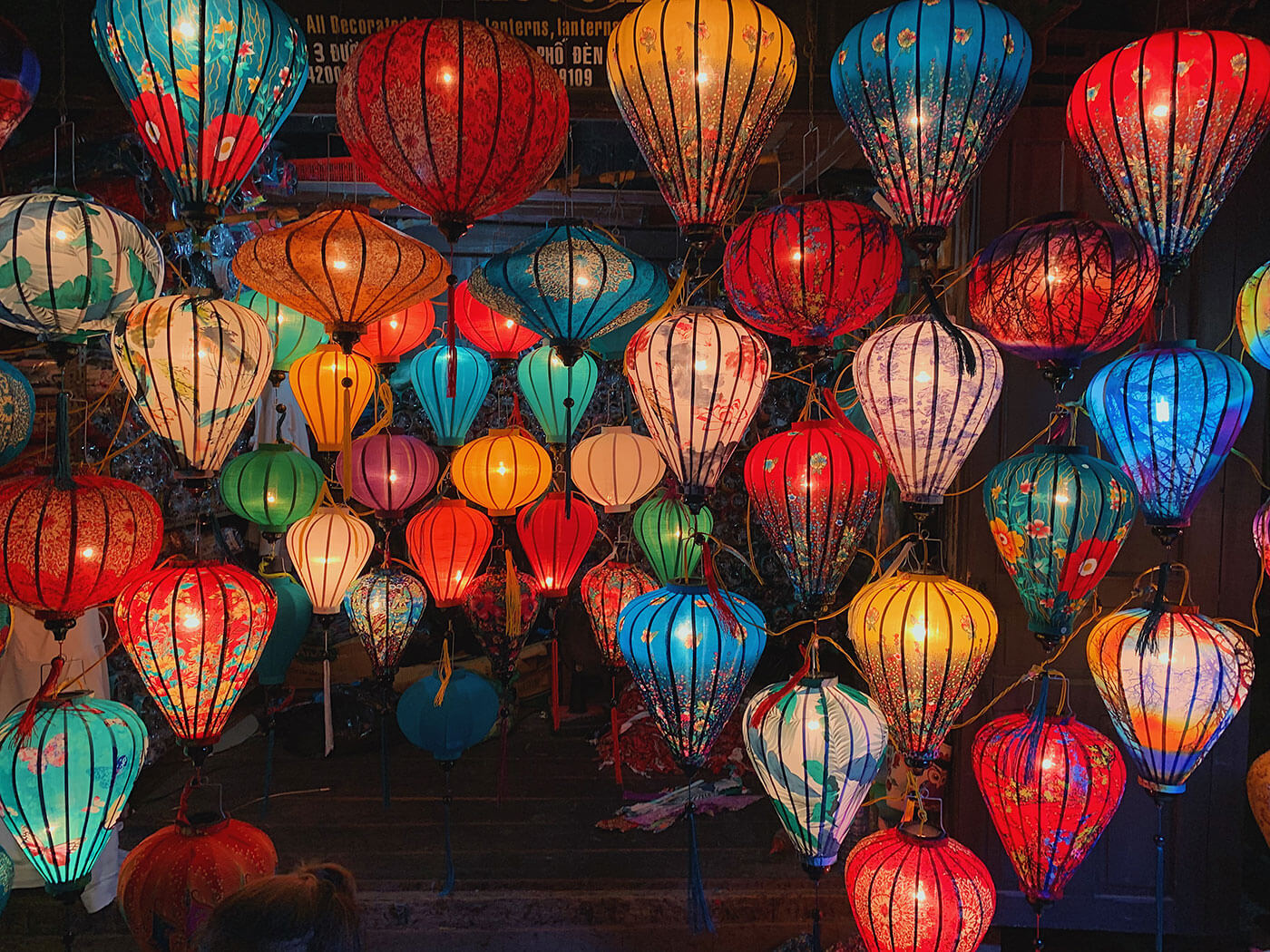
Well, I finally had the chance to visit Hoi An. I had actually been to Vietnam a few times before, but I never made it outside of the Southern regions. So, Hoi An is a completely unexplored region to me.
PS: If you are interested in some Hoi An travel tips and a food tour I went on while in Hoi An, scroll to the bottom of this post!
Okay, no more frills – let’s get straight into the food you must have in Hoi An.
1. Bánh Mì Thập Cẩm (Vietnamese Baguette Sandwich)
It’s truly crime to visit Vietnam and not have any Banh Mi. Banh Mi is a Vietnamese-style sandwich with various fillings – minced meat, liver pate, and fresh vegetables like lettuce, cucumbers, and pickled carrots.
What’s interesting about Banh Mi is that the bread is very similar to the French baguette – strong evidence of French influence on the region during the colonial period. However, unlike baguette which tends to be long, Banh Mi is noticeably shorter and fits just right in your hands.
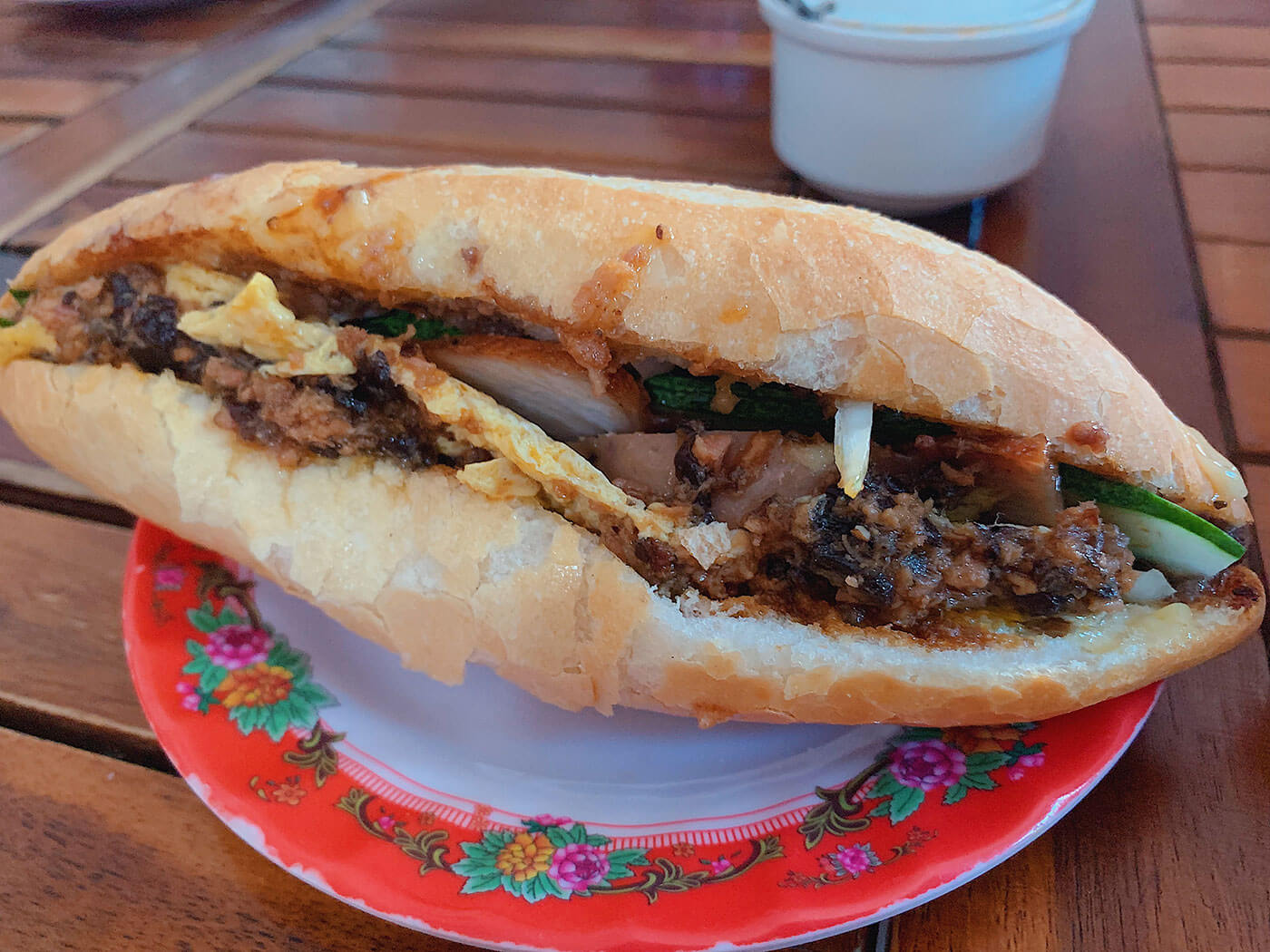
What is Banh Mi?
You’ll hear the word “Banh” used a lot in Vietnamese food, and you might wonder why. Well, the word “Banh” is used to describe anything made from flour! The word “Banh Mi” itself in Vietnamese actually just means “bread”. So, you cannot just order “Banh Mi” – you’d just be ordering the bread.
There are different types of Bahn Mi – sometimes with chicken, with vegetables, or a combination of meat and vegetables. My favorite is Bánh Mì Thập Cẩm, which is the combination bread – it’s got a little bit of everything! I loved the contrasting textures on each bite. The bread that is crunchy outside yet soft inside, the juicy meat, and then the combination of fresh and pickled vegetables.
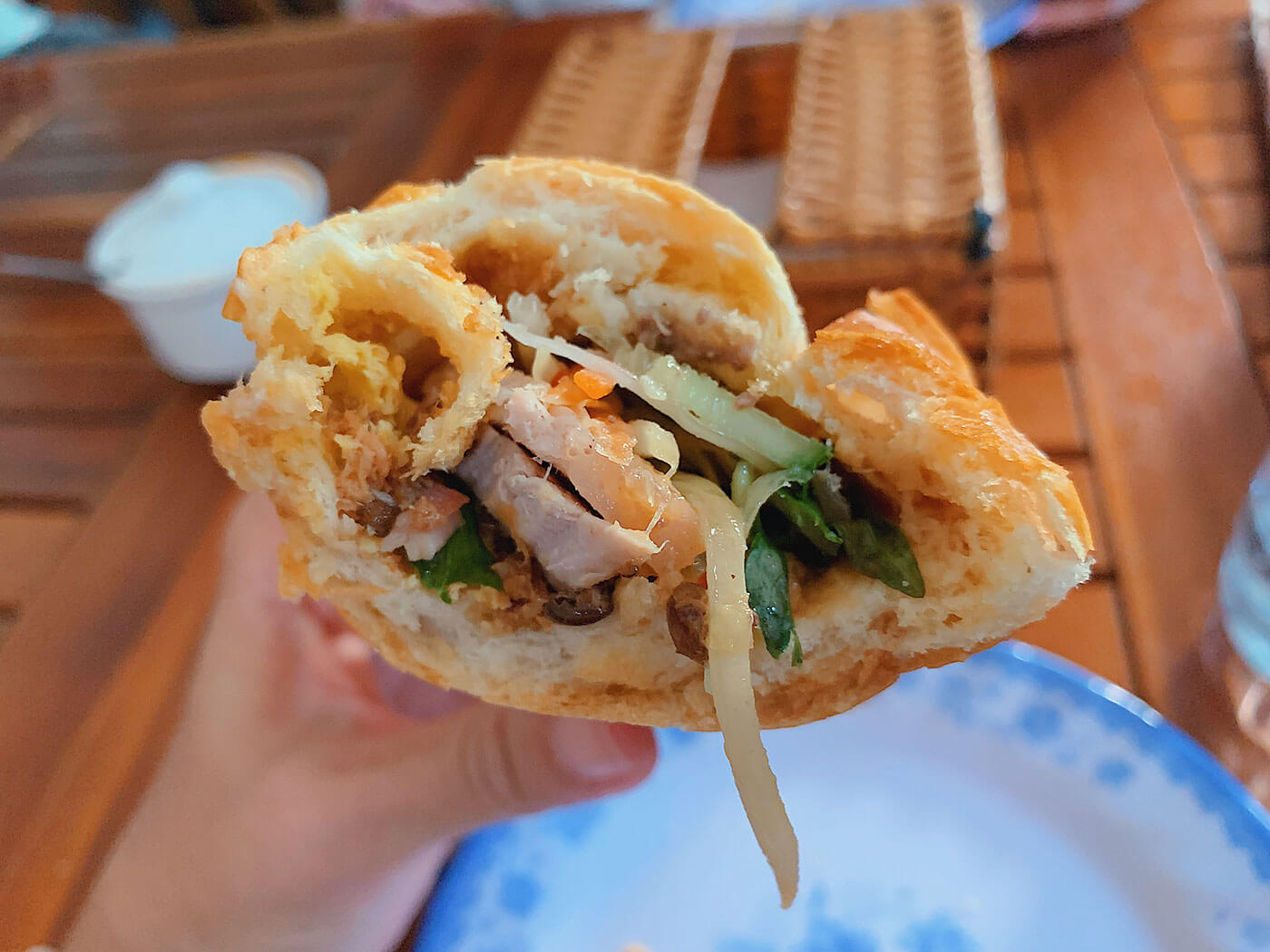
For uh, research purposes, I also ordered Chicken Banh Mi (Banh Mi Ga)… just to compare. While it was good, it wasn’t quite at the same level as Banh Mi Thap Cham. It has more meat, but it doesn’t have the crunchy fresh vegetables texture that are present in Banh Mi Thap Cham. The lack of texture alone, in my opinion, greatly reduced the tastiness of this sandwich.
Local Vietnamese normally have one Banh Mi for breakfast. At 20,000 VND (US$0.86) per sandwich, it is an affordable, nutritious and easy-to-have option for a complete meal to start your day.
Where is the best Banh Mi in Hoi An?
In Hoi An, there are a few places to get Banh Mi from but the most popular stores have got to be Banh Mi Phuong (rumored to sell 3,000 Banh Mi a day) and The Banh Mi Queen Madam Khanh (sells 1,000 Banh Mi a day).
The million dollar question: Which Banh Mi shop is better? Banh Mi Phuong became more famous as it had been hailed by Anthony Bourdain as the best Banh Mi in Vietnam in one episode of No Reservations. Great TV show and undoubtedly an excellent man, but clearly Bourdain hadn’t tried Madam Khanh’s Banh Mi. After trying both of Banh Mis (on the same day!), my friends and I unanimously agreed we loved the Banh Mi queen more!
To me, the Queen’s Banh Mi tasted fresher (more crunchy raw veggies) and less greasy, which makes it such a delightful experience to eat. In fact, we loved it so much that we ordered Banh Mi Thap Cham from Madam Khanh for breakfast every day for the three days that we were in Hoi An.
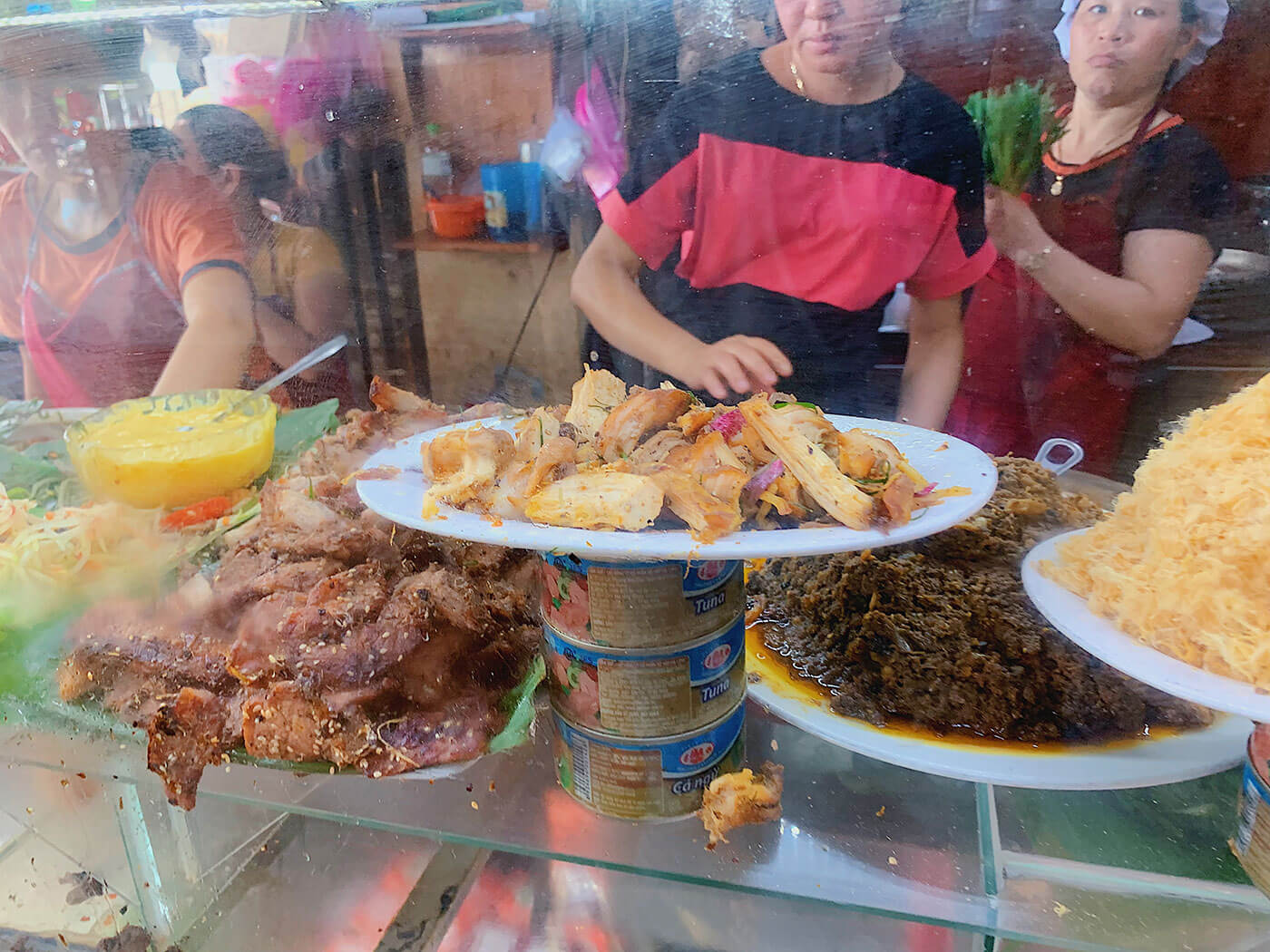
Here is a HUGE tip: If you are staying near the old city, you can get Madam Khanh’s Banh Mi delivered to you via Grab – the super app in South East Asia, kinda like Uber. Going to the restaurant is worth doing once for the authentic experience, but we visited Hoi An in May when it was REALLY hot (the mercury hits 37-39C during the day… if you can imagine). Walking around before 4 PM isn’t always feasible. I actually got a migraine from the heat, so having the Banh Mi delivered really helped. And, the delivery fee is very minimal – about 5,000 VND.
Where to get Banh Mi in Hoi An
2. Cao Lầu (Pork Rice Noodle)
Cao Lau is a noodle dish that is unique to Hoi An. On the menu, Cao Lau sounds like a typical Vietnamese dish – marinated roast pork slices and fresh green vegetables, over rice noodles.
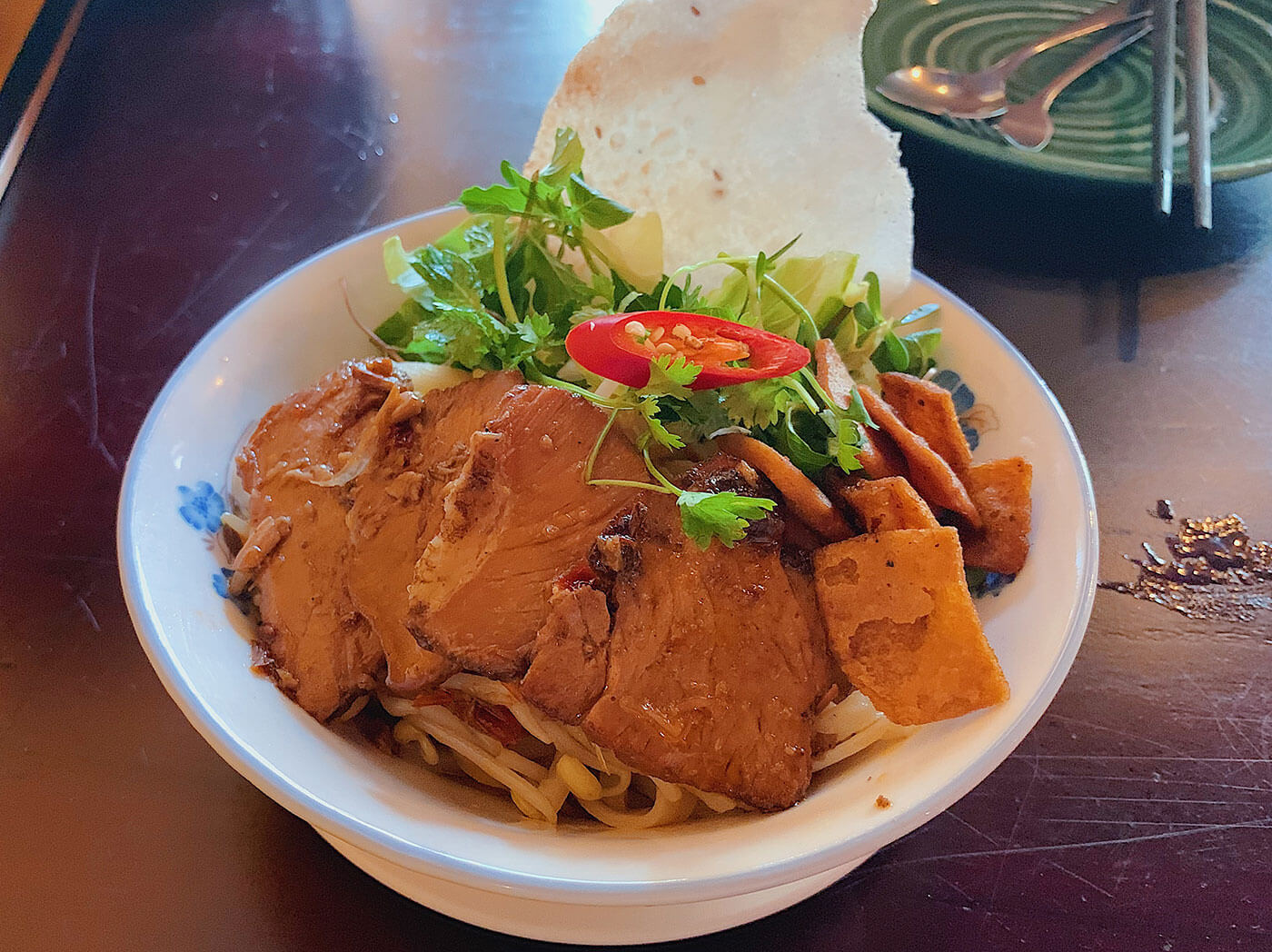
However, Cao Lau is rarely found outside of Hoi An due to the specific local ingredients that can only be found in this region – the noodles.
The rice noodles used in Cao Lau isn’t just any rice noodles. It has been soaked in calcium-rich water drawn from the local well, mixed with ashes from local trees in Cham Island. This gives the noodle a yellow-ish color and firmer texture than other rice noodles. There is even an ancient well (called Ba Le well) in the Hoi An old town, which is said to be the well where the Cao Lau water must be drawn from or else you can’t achieve the correct texture of noodles.
So you see, Cao Lau is a must-try when you are in Hoi An. You really won’t find this dish elsewhere!
Where to eat Cao Lau in Hoi An
- Morning Glory Restaurant (map) – Spoiler: You’ll see this restaurant popping up frequently on this list, just because it IS the best restaurant in Hoi An!
- Ong Hai Restaurant (map)
3. Bánh Bao Bánh Vạc (White Rose Dumpling)
Banh Bao Banh Vac aka the White Rose Dumpling is yet another dish that is uniquely Hoi An. It is a simple steamed dumpling with translucent white skin made from rice flour, filled with minced shrimp and pork and served topped with deep fried shallots.
Like Cao Lau, it is said the water used to make the skin on White Rose dumpling must be drawn from Ba Le well.
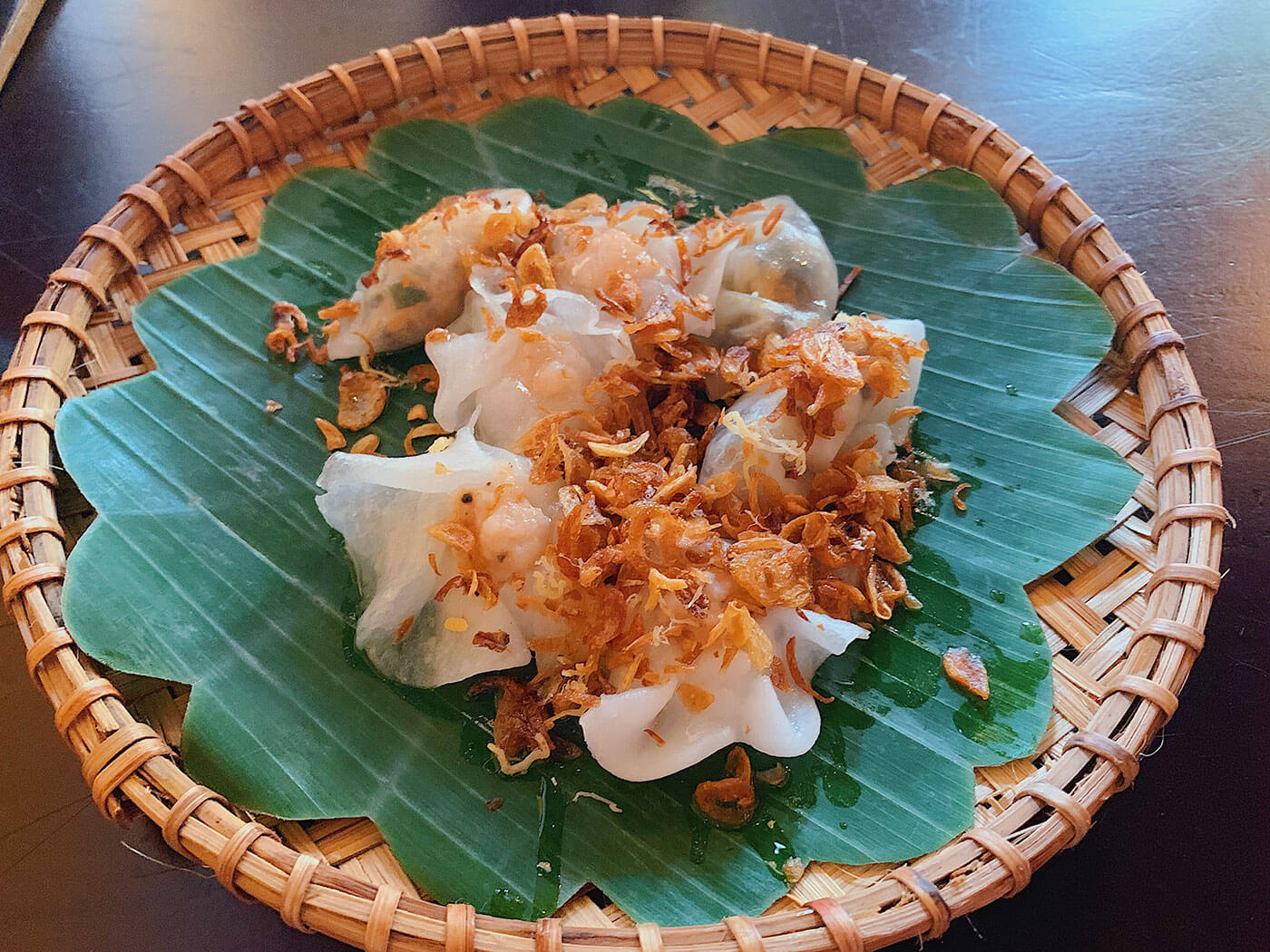
What makes this dumpling truly exclusive to Hoi An is that there is only one family that makes and supplies these dumplings all over Hoi An. It does not matter where you eat it in Hoi An, they’re all made by the same people! However, if you want the most original and freshly made version, you can head to White Rose Restaurant, operated by the original family and serves only White Rose Dumplings.
The dumpling gets its English name from the French who thinks the shape of the steamed dumplings resembles white roses.
Where to eat White Rose Dumpling in Hoi An
4. Cơm Gà Hoi An (Hoi An Chicken Rice)
Like its neighbors in Malaysia, Singapore, and Thailand, the famous Hainanese chicken rice also made its way to Vietnam and became popular especially in Hoi An. However, unlike the chicken rice found in the neighboring countries, Vietnamese chicken rice – called Com Ga – is served with shredded chicken.
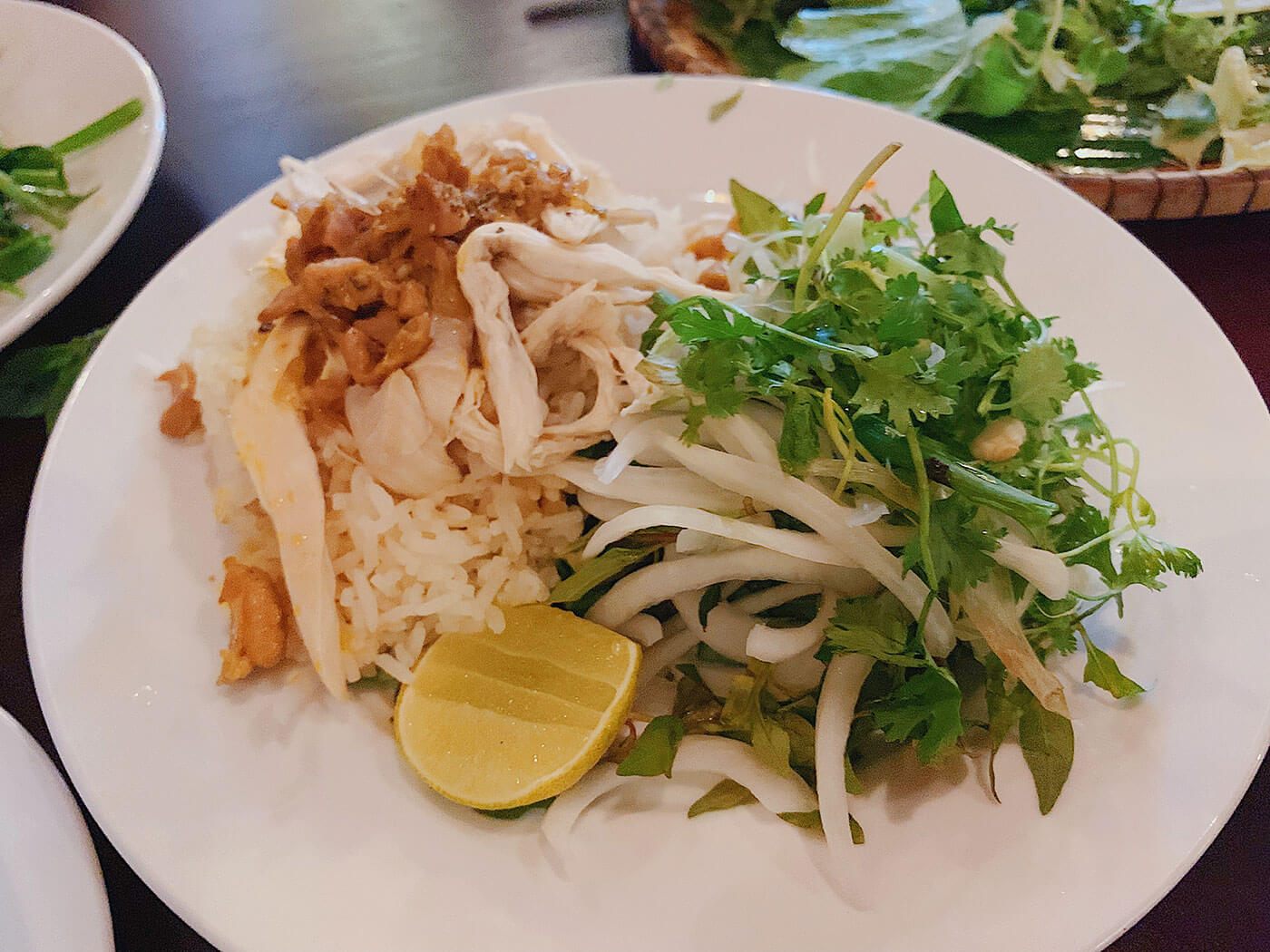
As with other chicken rice, the rice is flavored with chicken broth, but in certain restaurants, Com Ga also features a hint of turmeric in the rice, which makes it slightly more yellow than other chicken rice found in the region. And of course, true to Vietnamese dish, it is served with fresh greens and herbs on the side.
For me, Com Ga tasted a lot lighter and more fresh than the Hainanese chicken rice we find in Singapore. Very tasty!!
Where to eat Com Ga in Hoi An
5. Cà Phê Sữa Đá (Vietnamese Iced Coffee with Condensed Milk)
Vietnam is a country that runs on drip filter coffee. There are several ways Vietnamese coffee can be served, with the most popular way being Cà Phê Sữa Đá, which is iced coffee served with condensed milk.
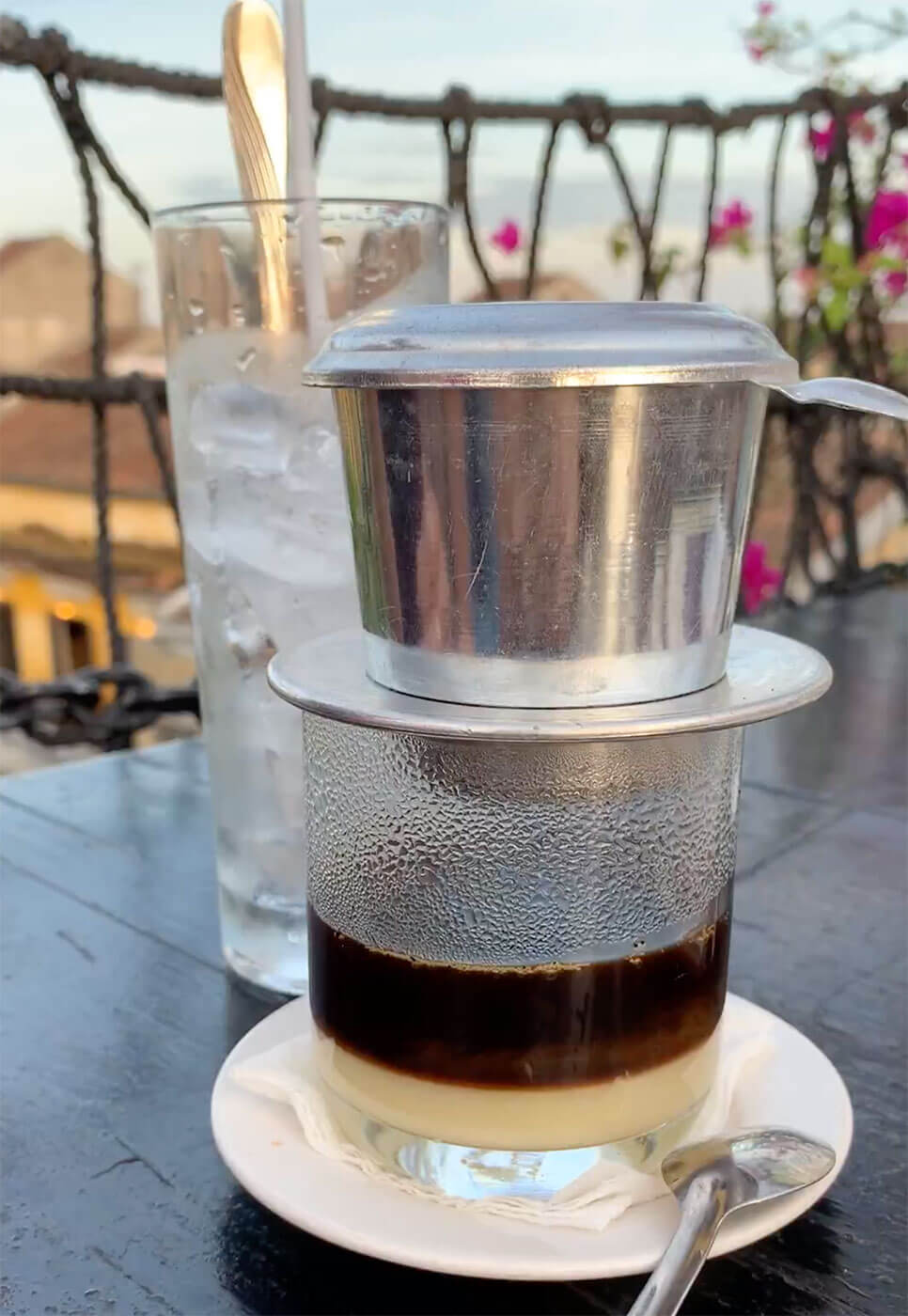
But if you want to skip the condensed milk, sugar, or ice – of course you can do that too! You can basically customize it to your liking.
Here are the many variations of Vietnamese coffee:
- Cà Phê Sữa Đá – Iced Coffee with condensed milk
- Cà Phê Đen Đá – Iced Black Coffee with sugar
- Cà Phê Đen Không Đường – Iced Black Coffee without sugar
- Cà Phê Sữa Nóng – Hot Coffee with Condensed Milk
- Cà Phê Nóng – Hot Black Coffee with sugar
- Cà Phê Đa Không Đường – Hot Black Coffee without sugar
The way to enjoy Vietnamese coffee is the same across the board for all types of coffee – first you put some dark roast ground Vietnamese coffee into a small individual metal drip filter. The filter is then put on top of a cup, where you pour hot water into the filter and let it slowly drip into the cup (which already has condensed milk in the bottom, if that’s what you want). Once the coffee stopped dripping, you stir the cup to mix the condensed milk and coffee, then pour it into a glass of ice, and… enjoy!
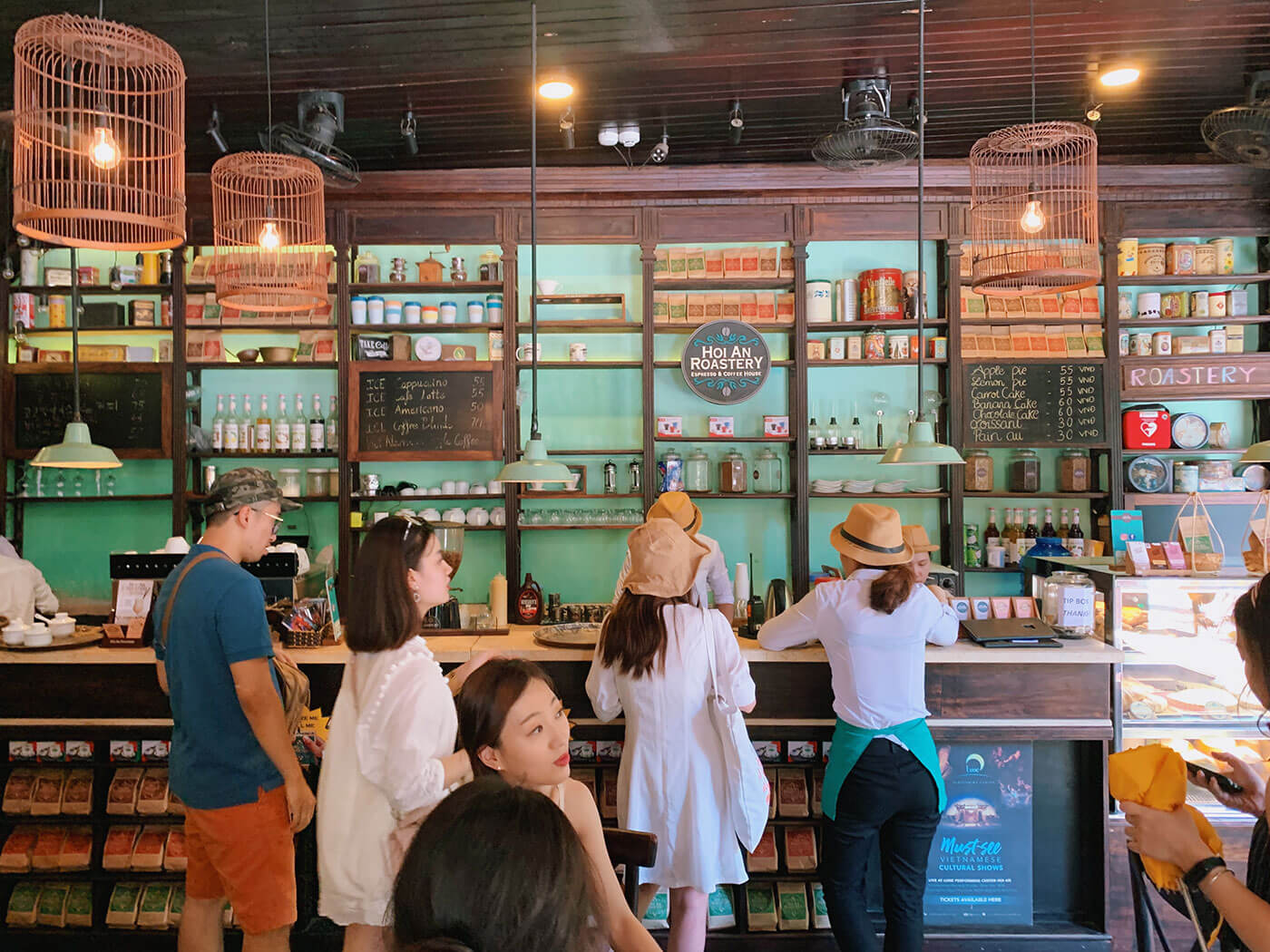

Where to have Coffee in Hoi An
- Hoi An Roastery (map) – this is just one of the locations, there are plenty of them in the old town
- Mê Hội An Rooftop Coffee & Kitchen (map) – head to the rooftop for sunset!
6. Mì Quảng (Quang Seafood Noodle)
Mi Quang is a popular noodle dish originated from Quang Nam province, the very province Hoi An is a part of. The dish contains a lot of greens and very little broth, which makes it a popular dish for the summer when it’s too hot to have any type of noodle soup (and again, I can vouch for how hot it can get in this part of the world).
Mi Quang is made differently at each restaurant and houses, but a popular topping is eggs, marinated pork, and shrimp.
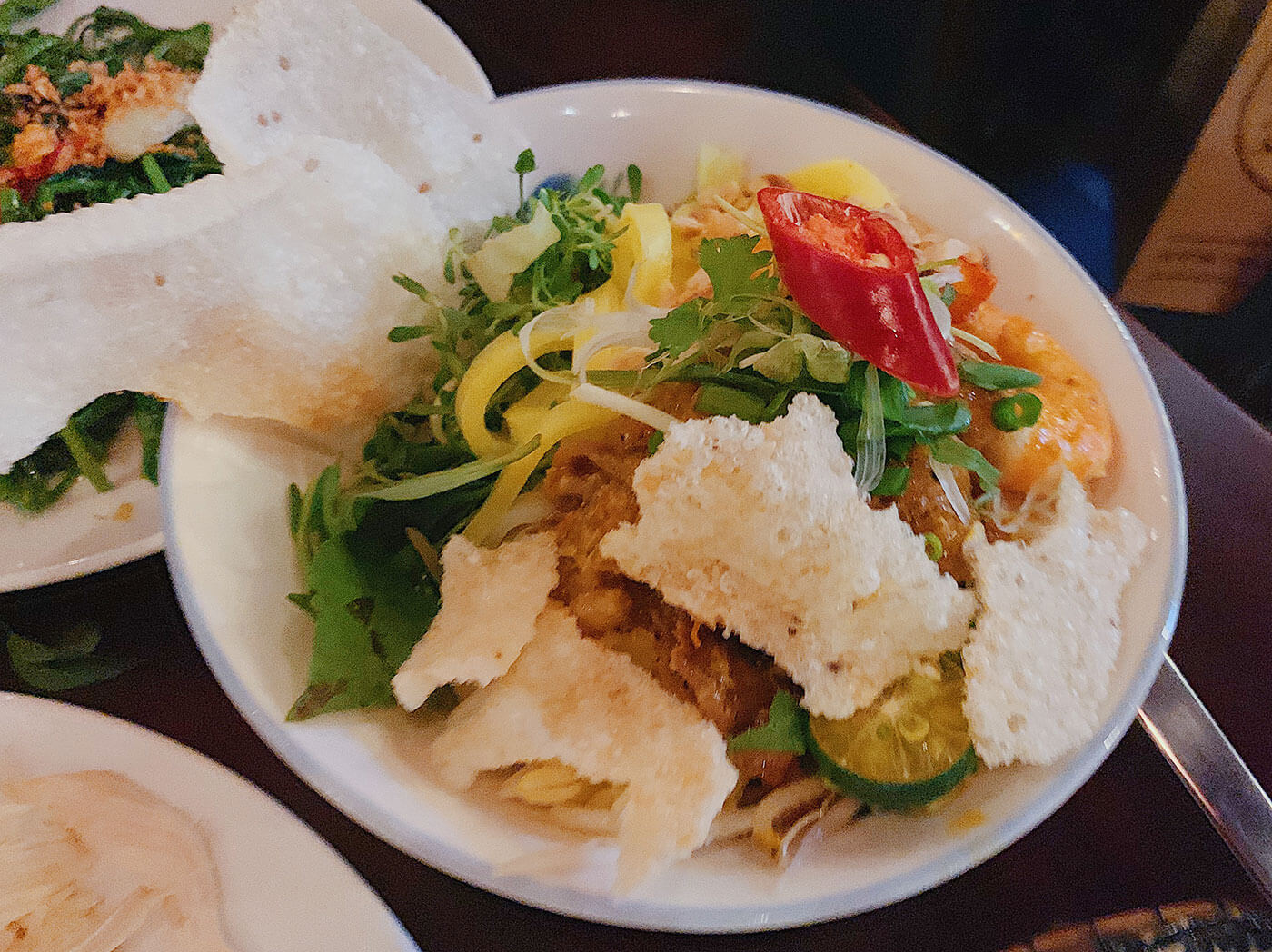
Where to eat Mi Quang in Hoi An
7. Bánh Xèo (Vietnamese Pancake)
Bánh xèo literally means “sizzling pancake”. This name came from the cooking process, mainly the loud sizzling sound it makes when the rice batter is poured into the hot skillet.
Banh Xeo is a delicacy that can be found all over Vietnam, but it’s only when I came to Hoi An (or more correctly Central Vietnam) that I discovered that each region has its own style of Banh Xeo.
In the south, such as in the capital Ho Chi Minh City, Banh Xeo tends to be a much larger pancake, the size of a dinner plate. Here in Central Vietnam, they are a more manageable size – about a quarter of a dinner plate.
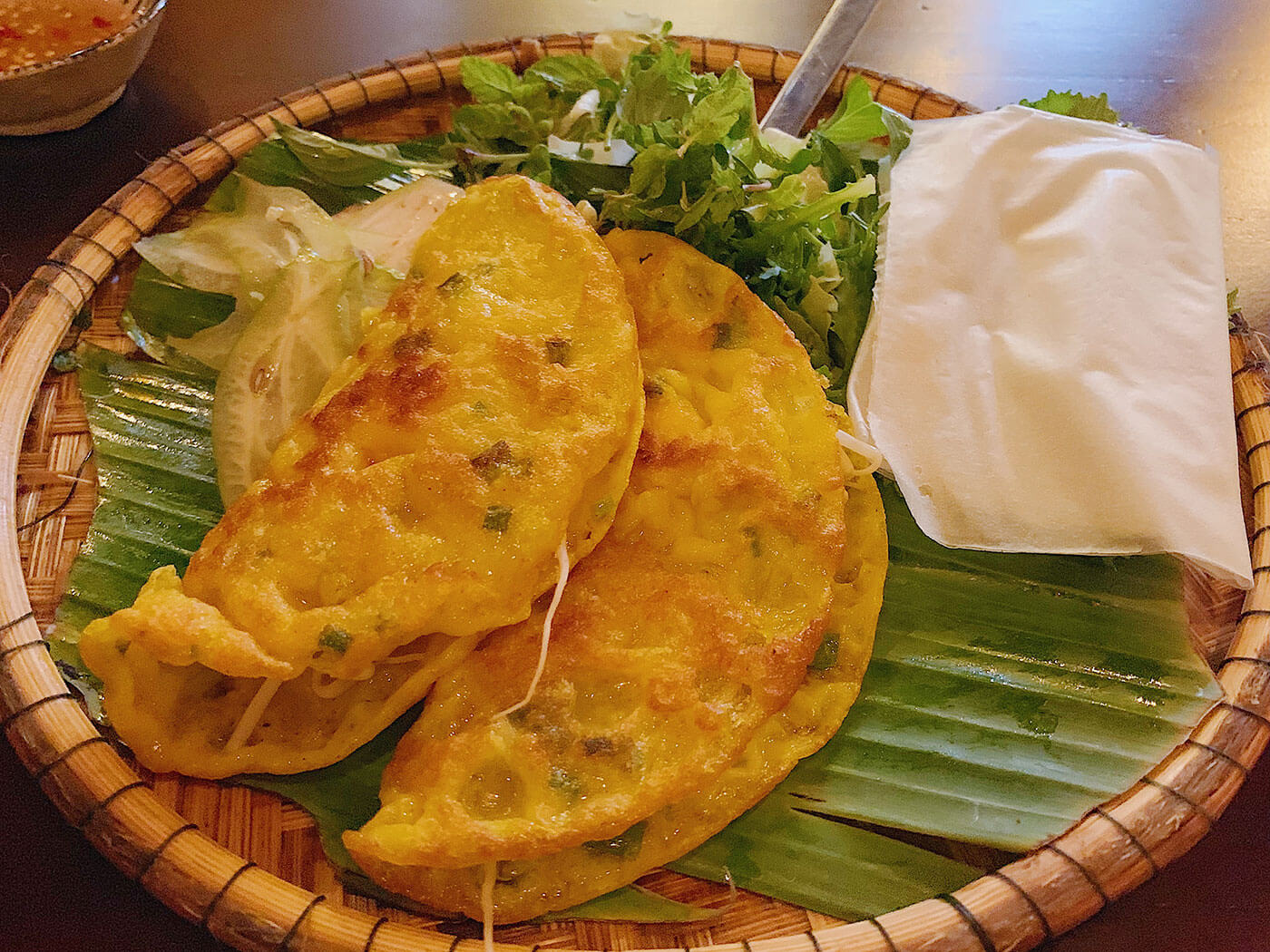
That white thing next to the pancake in my picture above? It looks like tissue, but it’s not – It’s actually dry rice paper! It’s not the usual rice paper you’d expect from Vietnamese cuisine – it’s the same one served with Thit Xieng Nuong (which I will elaborate more later). You can take a sheet of it and wrap the pancake inside with herbs and dip it into the dipping sauce that came with it.
Definitely one of my favorite item in this long list of amazing food.
Where to get Banh Xeo in Hoi An
- Morning Glory Restaurant (map) – the entire center of the restaurant is dedicated to a Banh Xeo station so you can see them in the making!
- MẸT Hội An (map)
- Bánh Xèo Minh Tú Chợ Hội An (map)
8. Bún Thịt Nướng (Grilled Pork over Vermicelli)
The flavors in a bowl of Bun Thit Nuong is often what I think of when I think about Vietnamese food. It is basically a “salad” of BBQ sliced pork, served over plenty of greens and cold rice noodle. It’s not specifically from Hoi An, but it is a popular dish all over Vietnam and a must have whenever you’re here!
Texturally, Bun Thit Nuong such a delight. You get the soft texture from the noodles, some hydration from the sauce and crunch from the vegetable. I loveeeeee them.
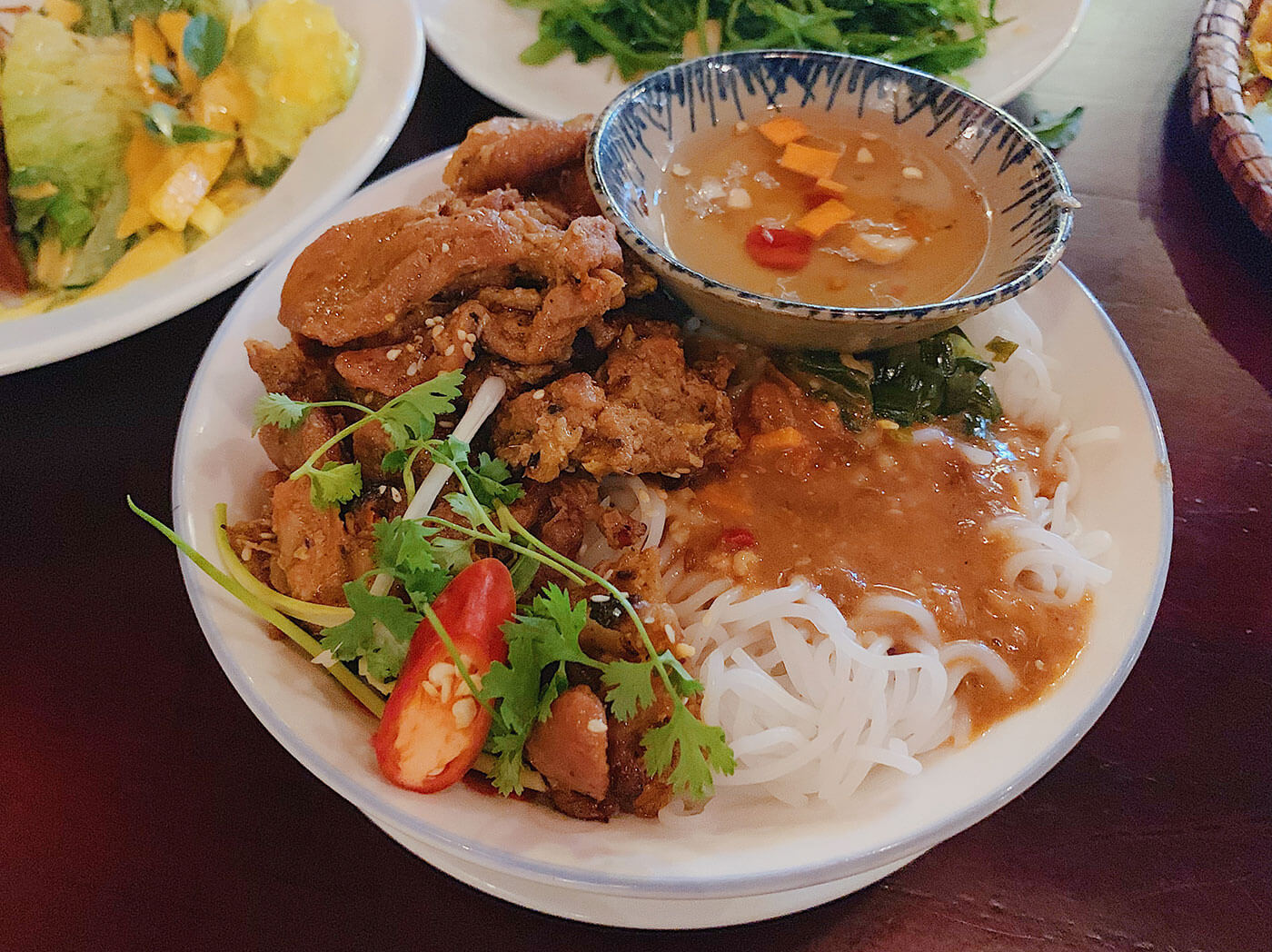
Where to get Bun Thit Nuong in Hoi An
- Morning Glory Restaurant (map)
9. Thịt Xiên Nướng (Grilled Pork in Rice Paper)
Thit Xien Nuong is considered street food in Vietnam, although the size of it is far from a simple snack – you can be full from having a few of these itself! It also contains complete meal-like ingredients: you’ve got meat, vegetables, and carbs in the form of dry rice paper!
The rice paper I had with the skewers are different than the ones I’m used to. Usually, the rice papers are soaked in water first before you use it as a spring roll wrap, but these rice papers are dry and crisp.
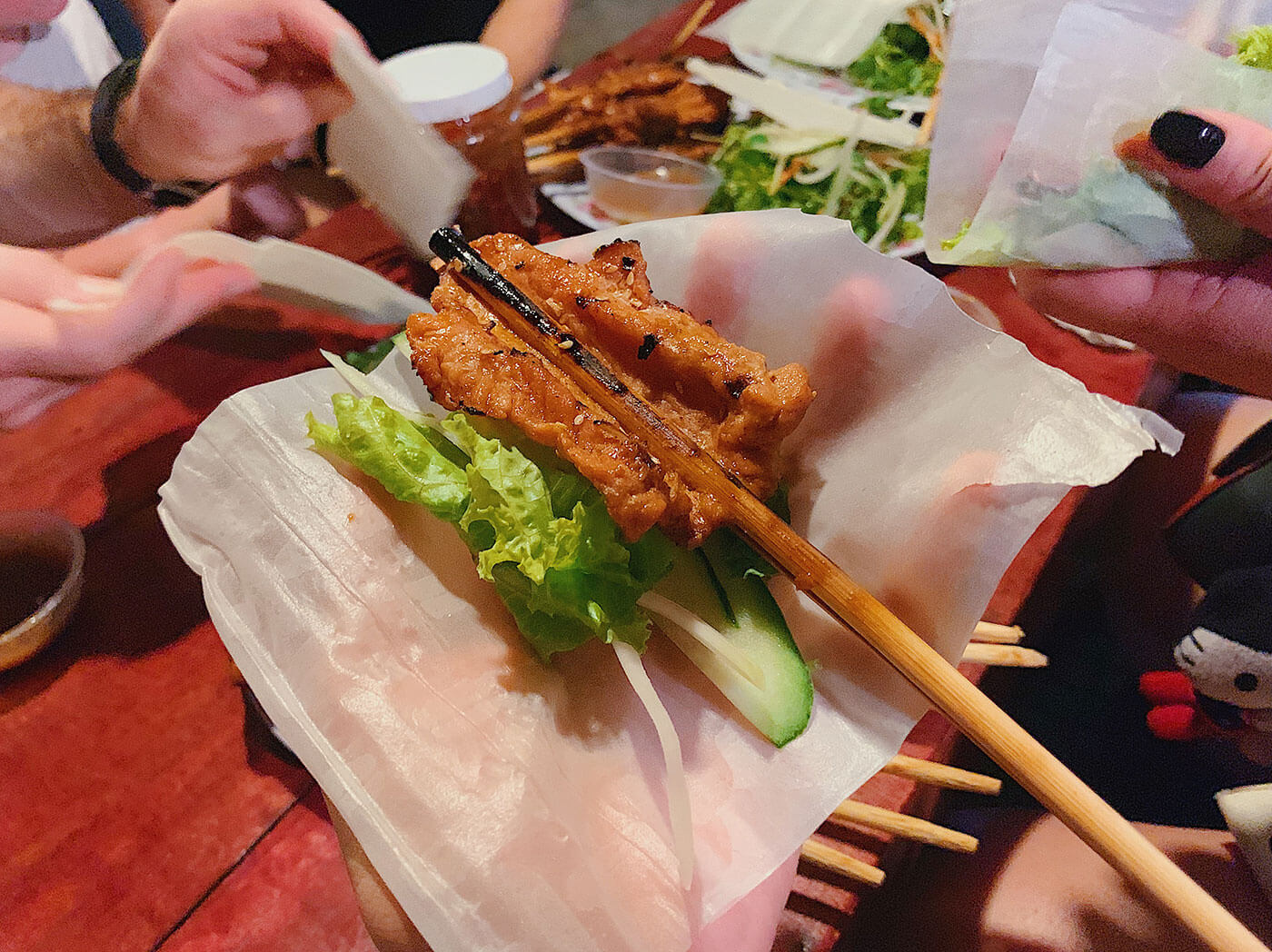
To eat Thit Xien Nuong like a local, do this: first place a sheet of the dry rice paper in your hand, take one of the skewers and put it on top of the dry rice paper, and garnish with the fresh vegetables and sauce. Then, you wrap the rice paper in your hand, and tightly wrap your palm (forming a fist) and pull the bamboo part of the skewer out so that the meat stays inside the rice paper. Fold it up together, dip in the peanut sauce and enjoy!
Where to get Thit Xien Nuong in Hoi An
- Thịt Nướng Cô Lợi Hội An (map)
- Small open-air stalls by the river near the Japanese covered bridge
10. Vietnamese Spring Rolls
Vietnamese Spring Rolls have been long in my list as a favorite appetizer. There are two types of spring rolls in Vietnam: Gỏi Cuốn, which is fresh Spring Rolls and Chả Giò (or Nem Rán in North Vietnam), which is crispy deep-fried Spring Rolls.
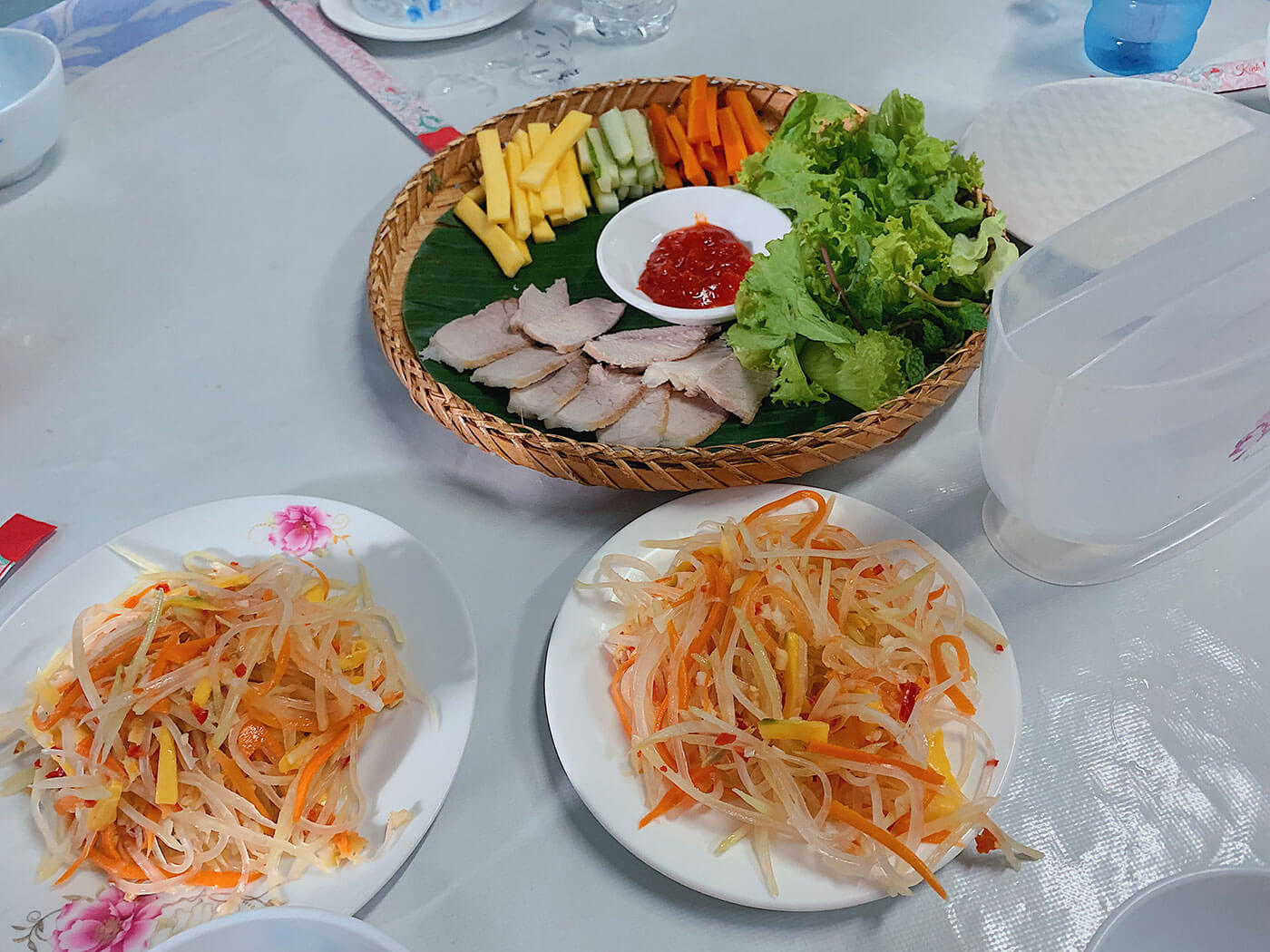
I’m more of a fan of the fresh spring rolls girl – I love soft rice paper and the contrasting texture of the raw vegetables inside. It’s also easy to make at home and a fun activity because you can just lay out the ingredients and add them to your spring roll as you eat, so you can customize how much of each ingredient you want in each of your rolls.
But during this trip, we got to try a deep fried spring roll with pork (Chả Giò)… and it was life-changing. Unlike other fried spring rolls, which are wrapped in flour-based wrappers, the Vietnamese ones are wrapped with rice paper. The rice paper, when fried, forms a very light puffed skin that is just delightful with the vegetables and pork filling inside. I’m a fan!
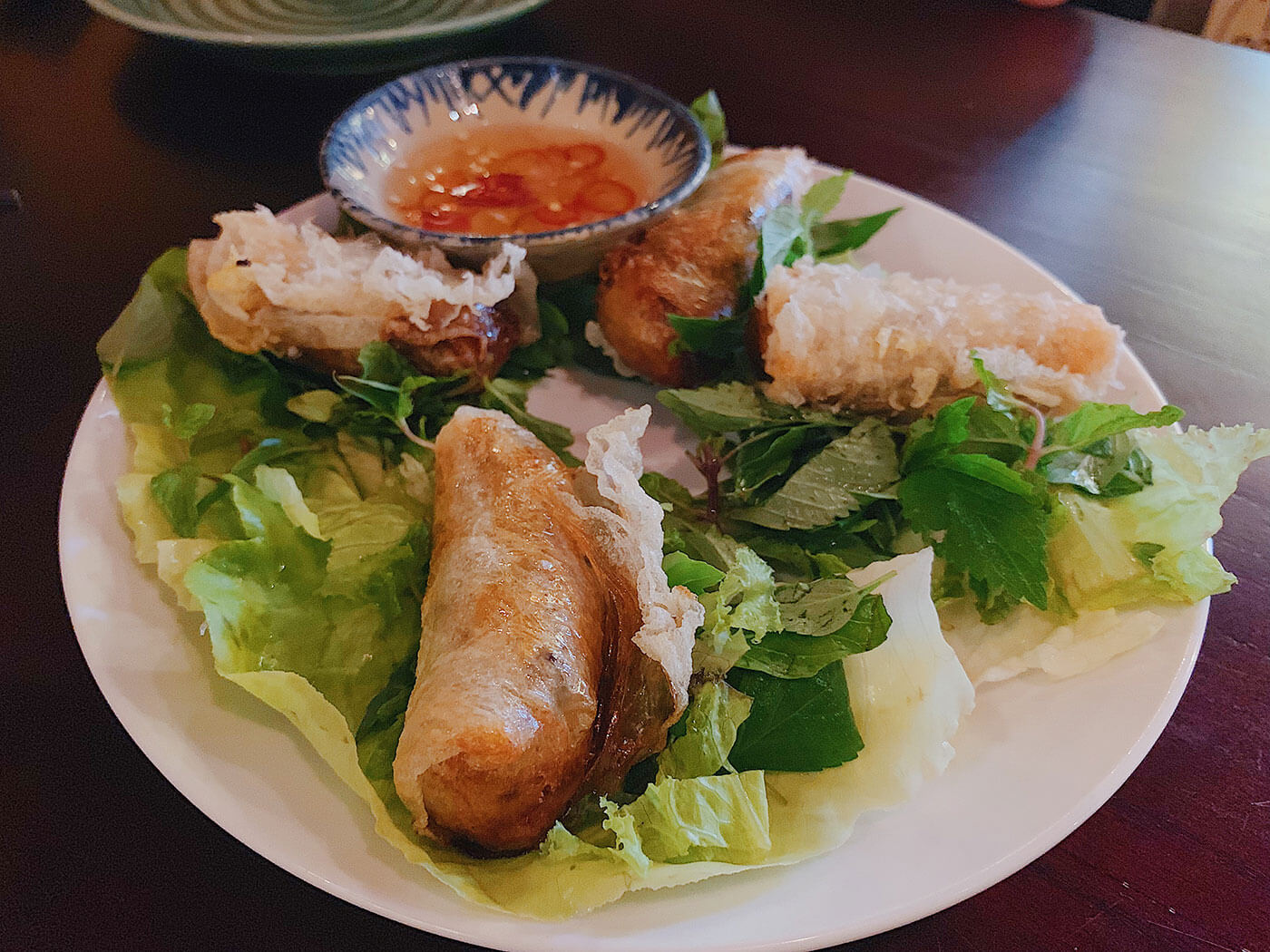
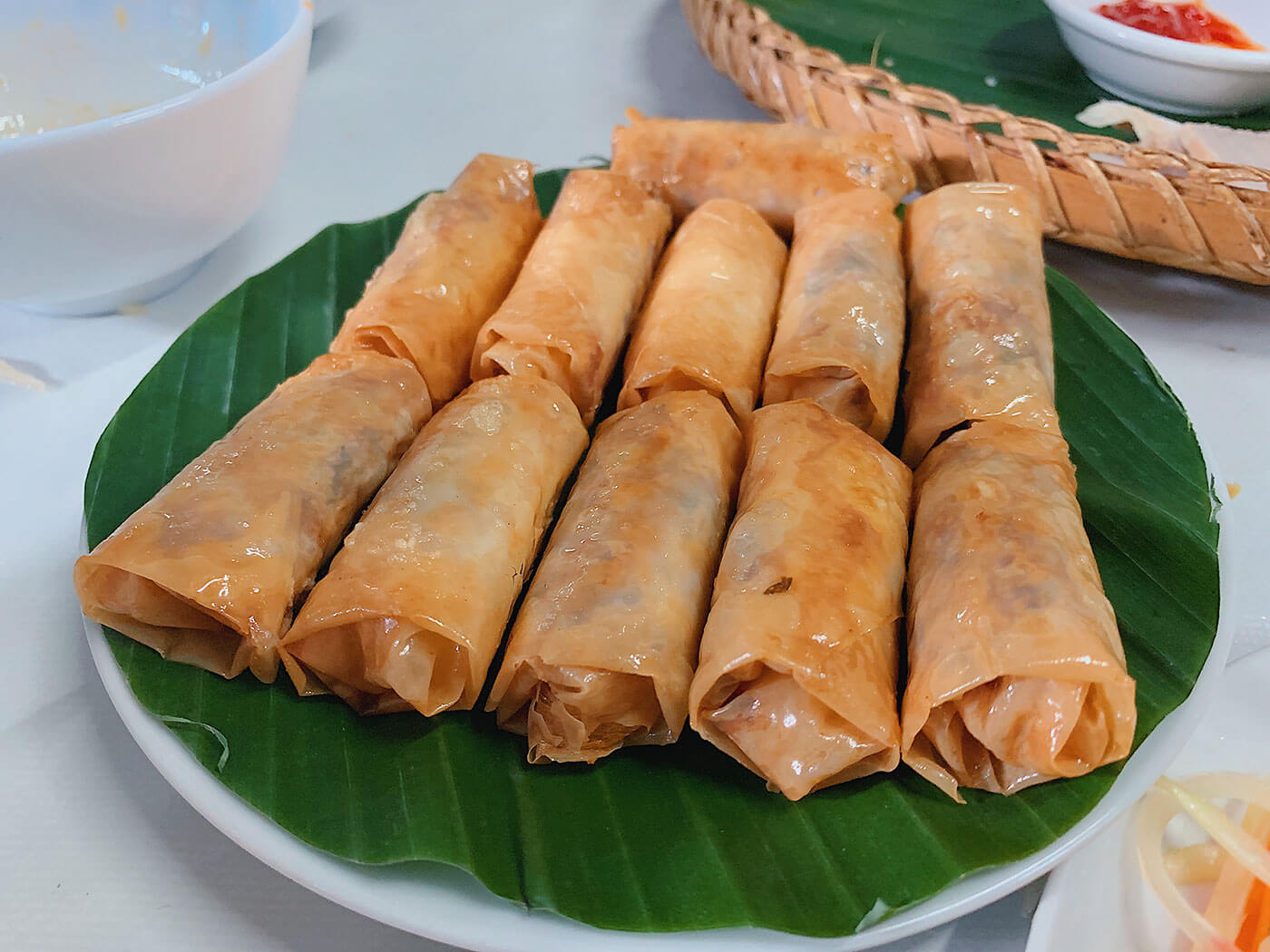
Where to eat Spring Rolls in Hoi An
- Morning Glory Restaurant (map)
- I also had this during the food tour I accidentally booked on my first night in Hoi An – more on that below!
11. Bánh Khọt Trứng Cút (Mini Pancake with Quail Eggs) – My favorite!!
Banh Khot is a very popular Vietnamese street food, made with flour, eggs, and simple toppings – basically a mini pancake! Usually, they are topped with shrimp but the variation I love is the one with quail eggs, called Banh Khot Trung Cut.
You pop these bite-sized babies straight into your mouth, and enjoy. Banh Khot is undoubtedly my favorite find on this trip. I still think about it a lot.
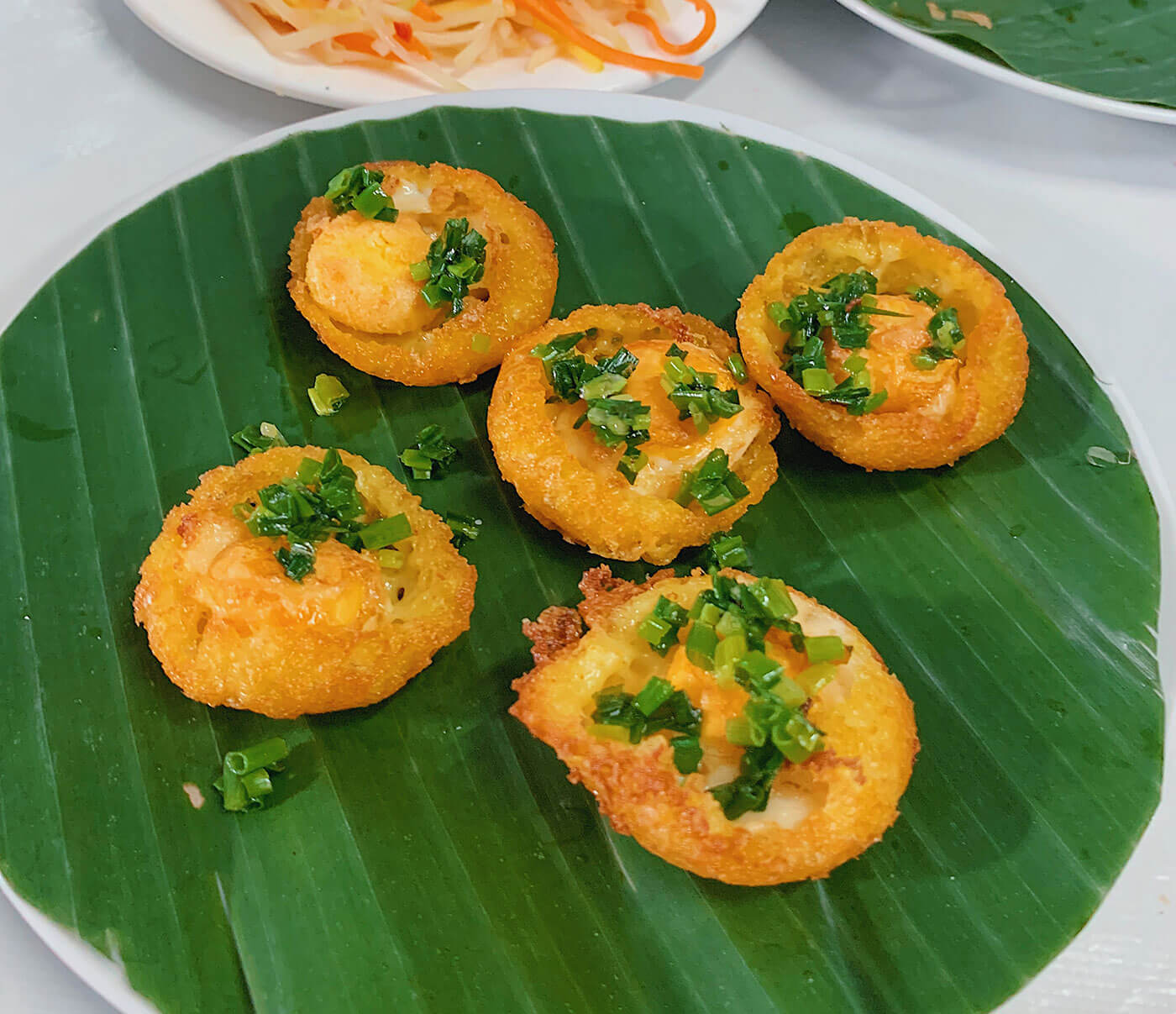
Where to eat Banh Khot in Hoi An
- Dung (map)
- Mrs Tuat Banh Can (map)
- I also had this during the food tour I accidentally booked on my first night in Hoi An – more on that below!
12. Pho Bo (Vietnamese Beef Noodles)
The most famous dish from Vietnam is undeniably Pho, a clear broth noodle bowl that is loved by many around the world. But, while I am a HUGE fan of pho, it’s placed last on my list since I didn’t actually have it on this trip. I visited Hoi An during one of the hottest months of Central Vietnam and I just can’t imagine eating Pho at that temperature.
However, if you are visiting Hoi An when the temperature is cooler, then you definitely have to try their Pho here! Pho is one of those dishes that varies across the region of Vietnam – clear and simple broth in the north and richer broth in the south. The central region’s Pho has been said to be a nice combination from the North and South.
Where to eat Pho in Hoi An
- Pho Thung (map)
- Pho Xua (map)
- Hoi An Central Market – you can find the stall where Anthony Bourdain had his pho when he visited!
BONUS: Iced Herbal Tea from Mot Restaurant
I didn’t include this in the list because it isn’t exactly Vietnamese food, but the herbal tea at Mot restaurant is worth a try if you’re already walking around the old town! ESPECIALLY when it’s hot outside. The tea is a refreshing blend of herbs (they actually have all the ingredients laid out, but i couldn’t identify them…).
I especially love how it was served with a lotus petal, in an unlined paper cup and with a lotus stem straw instead of plastic! It’s so pretty.
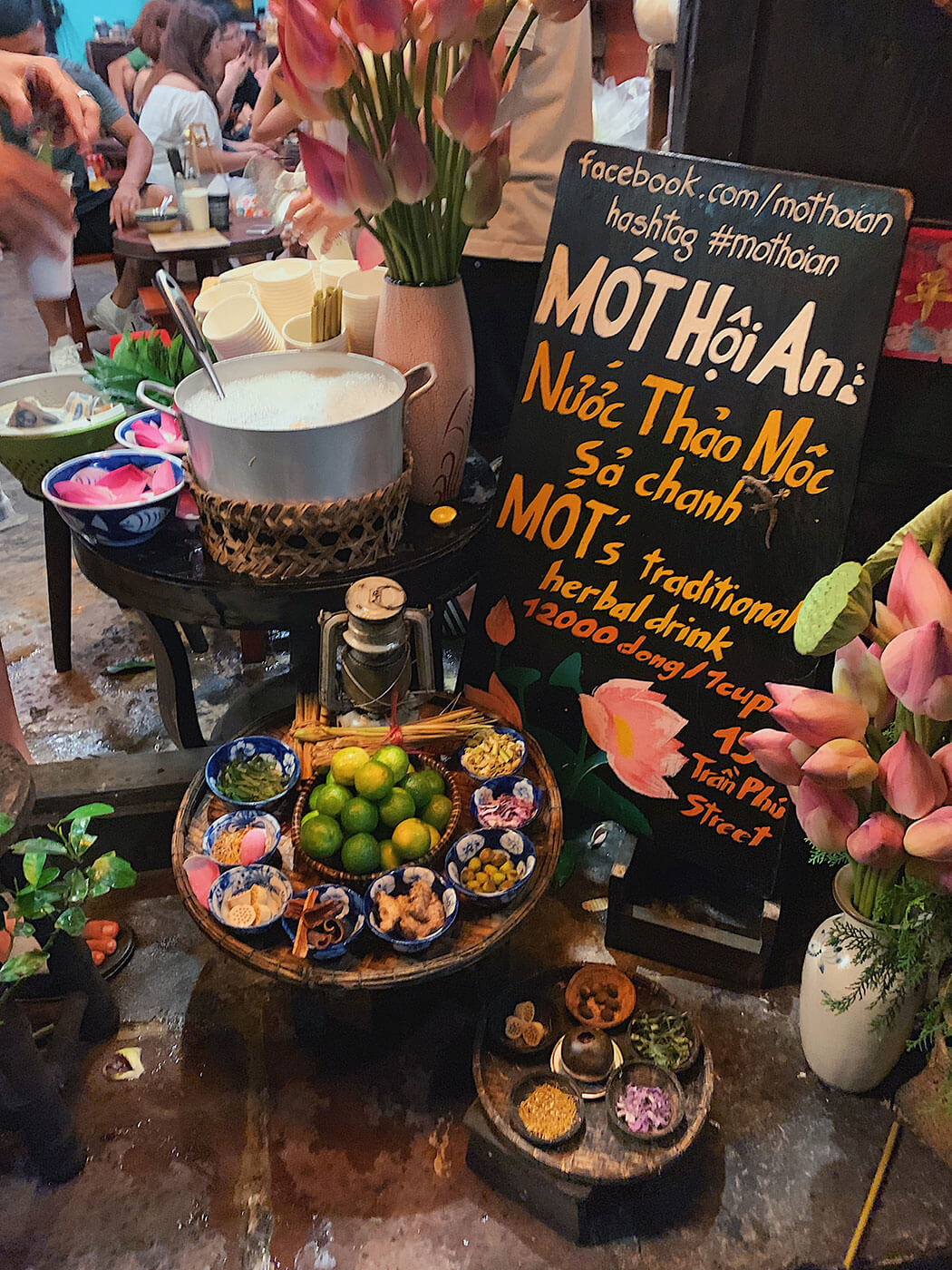
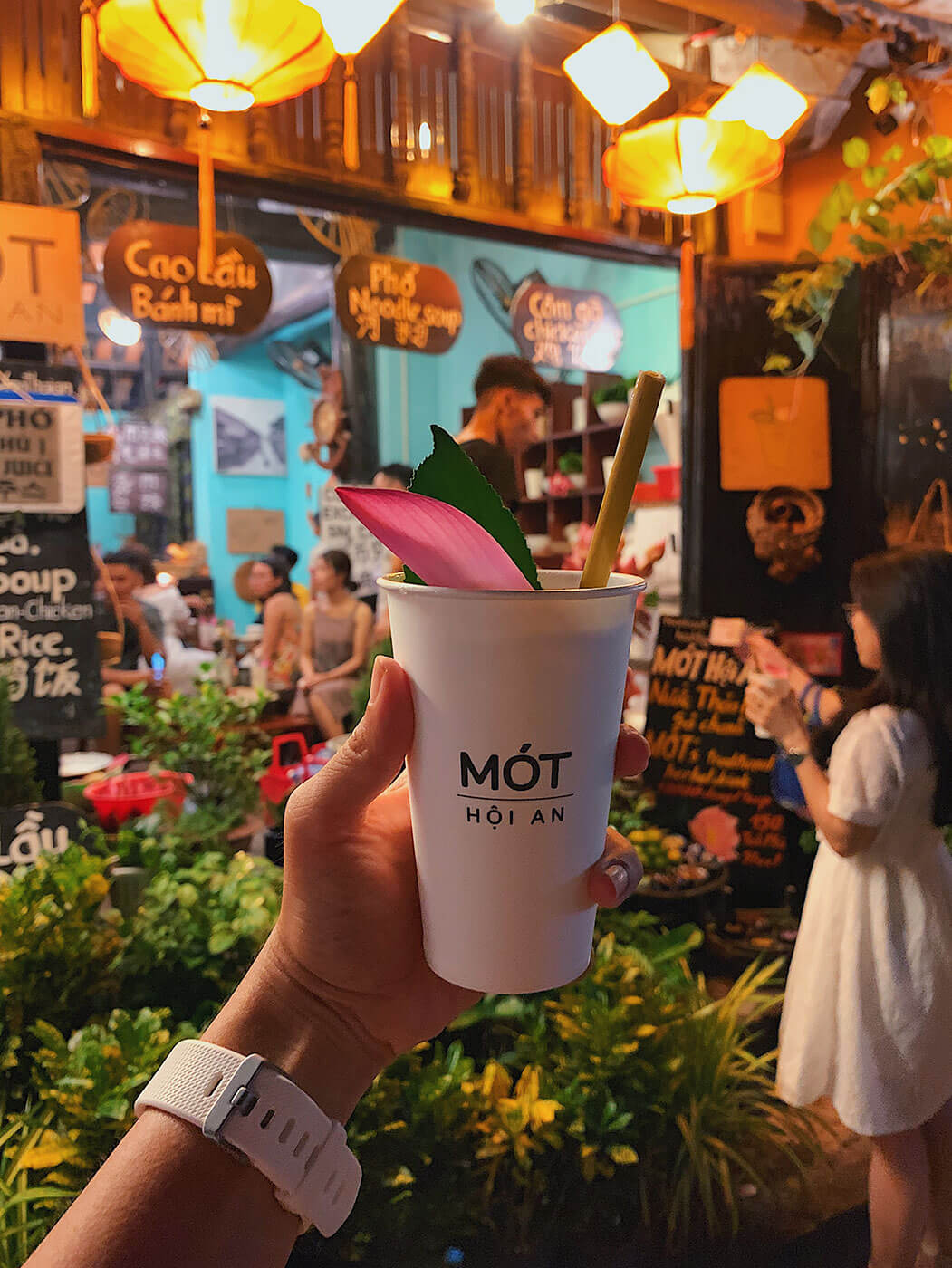
Hoi An Food Tours
Want to have all these local dishes in the presence of a local? I highly recommend booking a food tour. I love going on food tours on my travels. You get to find out more about each dishes and how it plays a part in local culture when you have someone local takes you around!
Here are a few options for Hoi An:
- Hoi An City Evening Tour – This is the one I booked. Don’t be confused by the title of the tour the “Join in Evening Tour” is actually a food tour, where I got to sample some of the dishes I listed. More details below.
- Hoi An Street Food Walking Tour – looks similar to the one I booked, except it has Cao Lau instead of home cooked food.
- Hoi An Private Food Tour – If you don’t want to be joined by anyone else, you can consider this tour for slightly more premium price.
Review of the Hoi An Food Tour I booked
So I told you about how I accidentally booked a food tour on my first day in Hoi An before. Here’s the full story: I was looking up activities for our first day in Hoi An. As we will be arriving at noon, I thought it would be great to get a tour around the city for our first day so we can get a bearing of the city and learn some history at the same time.
So I booked this Hoi An Evening City Tour which sounds perfect. Well, turns out I didn’t look into the itinerary closely enough – it actually included a bunch of food stops… because it’s actually supposed to be an evening food tour. Story of my life really, even when I’m not looking for food, food looks out for me!
But my friends and I are very keen on trying local food so it ended up being a win-win situation for us. During the tour, we got to taste:
- Banh Mi at Madam Khanh The Banh Mi Queen
- Home cooked food at a local’s house (Spring Rolls – both fresh and fried, Banh Khot, and a dessert called Che)
- Vietnamese Coffee while watching the sunset
- Thit Xien Nuong by the river for dinner (though by this time we were already so full!)
Aside from the food, the tour also includes a boat ride on the river and a 15-minute foot massage. Overall, even though I was not expecting it to be a food tour, I was super happy with it!
Our guide Emma is a local from Hoi An, who is very informative and speaks really good English. She was able to answer any curiosity I had about the food or about Hoi An in general and is one of the reasons I am able to write a lot of details in this post. Thanks Emma!
Hoi An Travel Tips
What’s a travel blog without actual travel tips? 🙂 Below I’ve noted down a few useful tips I learned during my trip.
- To get to Hoi An, the best way is to fly to Da Nang and hire a car to take you to Hoi An, approximately 1-hour drive. I booked a private airport transfer to pick us up to and from Da Nang Airport. The car can be shared with a group, very affordable, and they are extremely reliable.
- The currency in Vietnam is VND, aka Vietnamese Dong. You can still trade in USD if you have some, but if you prefer to trade in the local currency, then be prepared to deal with a lot of 0’s. At the time of writing, US$1 is equivalent to ~23,000 VND.
- Download WhatsApp – this is the popular messaging app, tied to your phone number, in South East Asia and it’s how locals and tour groups can communicate with you.
- Get a prepaid Data SIM Card. SIM Card costs US$7-8 for unlimited data at the Da Nang Airport with Vinaphone. Alternatively, You can pre-buy SIM card here for cheaper and pick it up at the Da Nang airport, although it has a data limit of 5-7 GB, which should be plenty for 3 days. The 4G is good here and the data connection is very fast so I recommend getting it.
- Pay attention to the months that you plan to go, as the heat can be quite extreme in this region. I came to Hoi An in May, and as I have referenced many times in the post, it was one of the hottest Months in the central region with temperature in the 37-39C region in the day and low 30s at night. It severely impaired our ability to walk around the city – the weather only gets bearable around 4 PM, and as I said before I even got a migraine from the heat and lack of hydration. Speaking of hydration, you’ll NEED to have at least 2L of water every day if you plan to be outside. Don’t have anything less, because you will sweat a lot.
- The best months to come to Hoi An is December to February, when the weather is MUCH more bearable. But it is also considered peak tourist time.
- To get around Hoi An attractions that are out of the city, you can hire a private car charter for one day especially if you want to go to Ba Na Hills or My Son temple. Side note: This private charter is awesome. They showed up on time (I requested an early pick up at 6 AM) and are so responsive on WhatsApp throughout the trip. I actually did a very stupid thing and left my phone in the car after our activities are done, which as you can imagine was an extremely stressful ordeal as I had everything on that phone including the tour contact number. But I managed to get in touch with them via Klook and I had my phone back in my hands not even 15 minutes later. THANK YOU SO MUCH GUYS!!
What to do in Hoi An for 3 days
If you find yourself in Hoi An for 3 days, or if you’re just wondering what you can do in Hoi An, you can head over tho this Hoi An travel guide I wrote: What to do in Hoi An in 3 Days
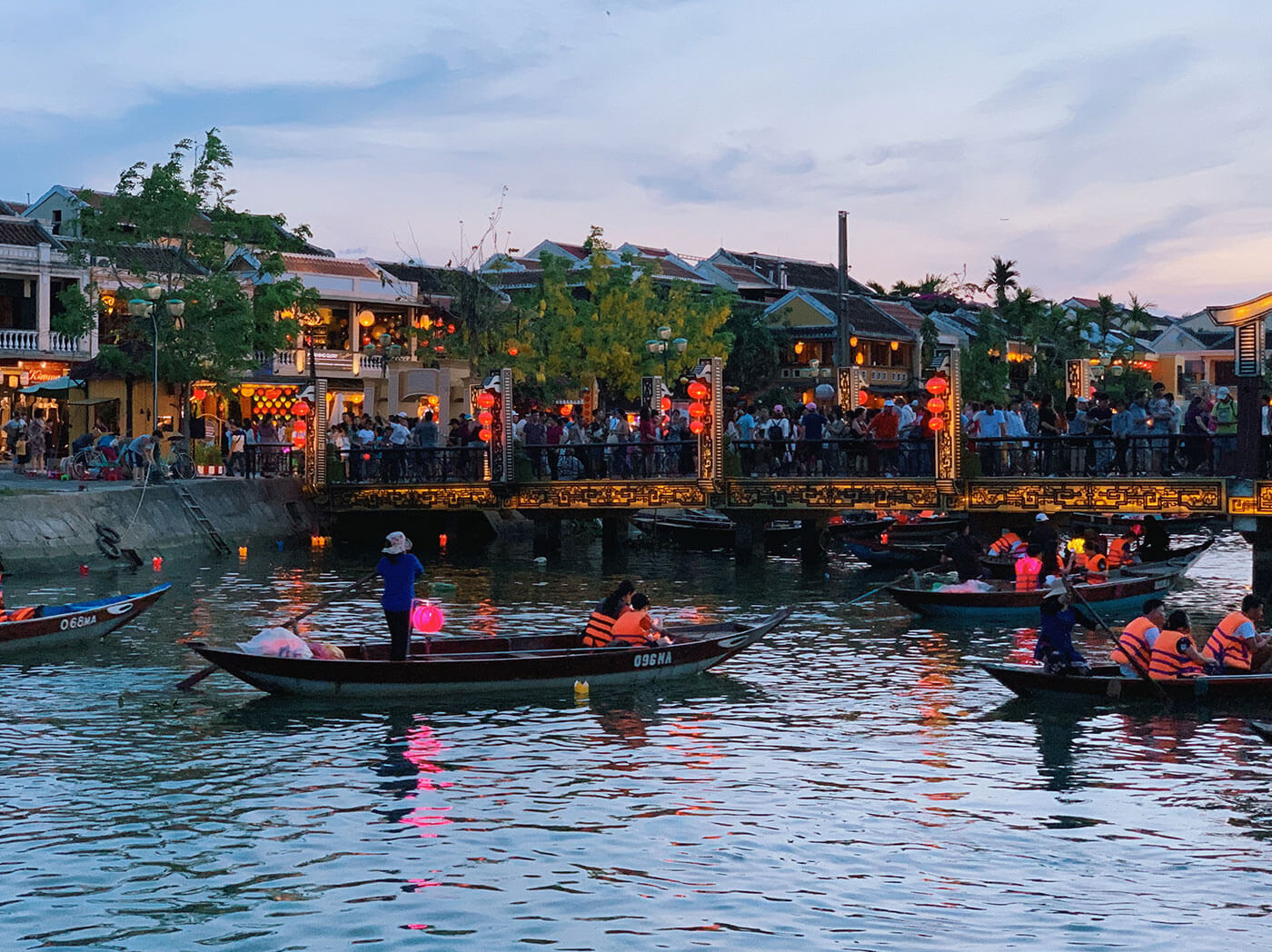
Where to stay in Hoi An
We stayed at a homestay about 5 minutes walk from the Old Town Hoi An and 2 minutes from the Night Market, called L’Ami Homestay.
It’s a cute and nicely renovated 4-story house converted into a small hotel. The staff is extremely friendly and breakfast is served every day (although we ended up ordering in Banh Mi from Madam Khanh for most of those days…). Be warned though – there are no elevators so if you booked the triple room with terrace, it’s going to be 4 flights of stairs to the room every day to get back to your room. Personally, I thought it was not that big of a deal.
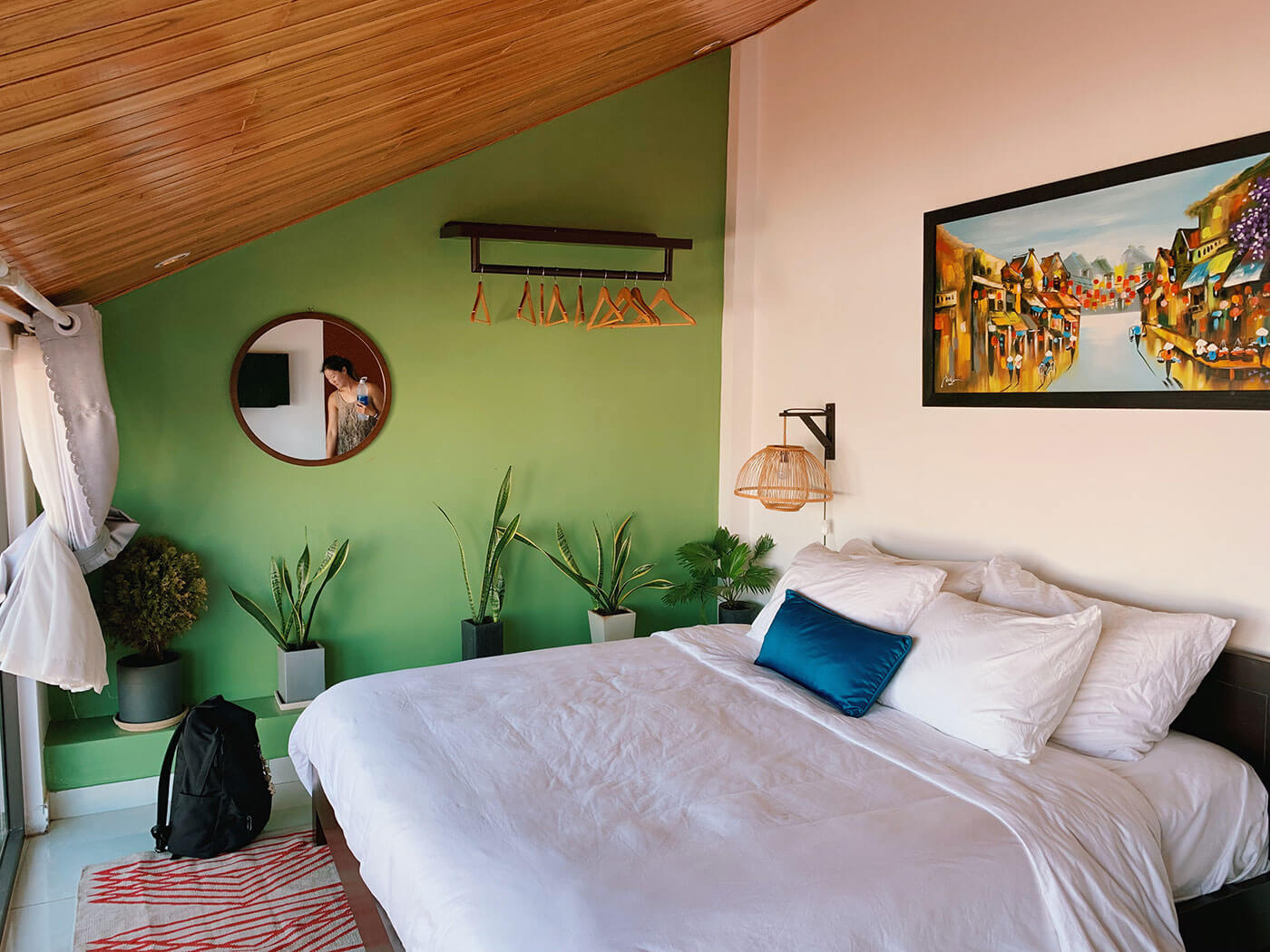
And that’s all from me on Hoi An! If you find this useful, please leave a comment below. I love reading your comments!

Thank you for your post! I just came to Hoi An and followed your food recommendations and they are 10/10!!! Morning Glory is absolutely amazing, worth the (long) line!
Camila, thanks for your comment! I am glad Morning Glory is still good!
Whenever we praise someone, we give him a number, like if I appreciate your post from one to 10, I would like to give you the full number of 10 because you wrote your post very well. The word is very beautiful. I hope you will keep writing such excellent posts in your life and we will definitely comment by reading these posts.
You are spot on about Morning Glory (Original)!!! Had the amazing Cao Lau and White rose dumplings. The Duck Breast dinner was out of this world too! Thank you for all your Hoi An food advice😊
Dear Ms, Melissa,
Thank you so much for you great artcle. We love your experience in traveling around the world and your valuable sharing! It is really impressive! We also love Vietnam and when the pandemic gone, we will travel to Hoi An and of course we will taste all of your recommendation.
Take care!
Everything looks very appetizing! I definitely want to try Vietnamese food …
You’re really making me want to go back as I didn’t eat enough in Vietnam and wish I ate more food like this. Thanks for the recommendations!
Thanks Melissa
Very informative and to the point..
Great tips to follow
We are travelling to Hanoi, Sapa and Ho Chi Minh City
Any ideas on these fronts
How do I follow you
If you are ever in Australia ( Melbourne) you have a place to stay 🙂
Wow, these foods are really great, I feel very hungry right now. thanks for introducing.
Very good post with many choices of meals and seemed so delicious! it gives me a lot of ideas for a next trip! Your accommodation is also a good advice. Thank you for these detailled information!
Dear Melissa! Thank you very much for you coming to Ylang Ylang spa during your trip in Hoi an. And thanks again for your wonderful review on our tripadvisor https://www.tripadvisor.com/ShowUserReviews-g298082-d10001232-r677252587-Ylang_Ylang_Spa-Hoi_An_Quang_Nam_Province.html.
Ylang Ylang spa hope you always have a lot of beautiful trip over the world and eat all the world 😀
Number 1 and number 11 are excruciatingly mouthwatering! Do you have any idea how do you prepare them?
Where is the map you refer to